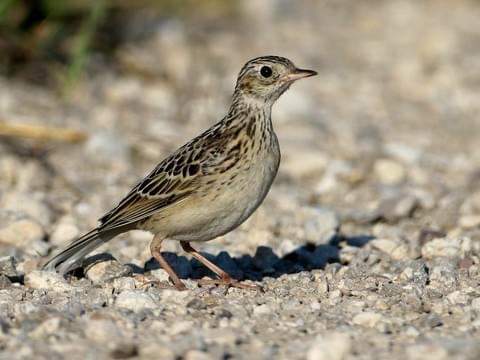Sprague’s Pipit

- Scientific name: Anthus spragueii
- SARA Status: Threatened
- COSEWIC Status: Threatened
- COSEWIC Range: Alberta, Saskatchewan, Manitoba
Sprague’s Pipit is a medium-sized, ground-nesting bird that is rarely seen. It is usually only detected by its unique song, which is often described as a series of descending tinkling, ethereal notes.
The Sprague’s Pipit is an inconspicuous migratory species that doesn’t have any uniquely distinguishing features other than its thin bill and large, brown eyes. They are endemic to Canadian prairies in Alberta, Saskatchewan, Manitoba, and the northern Great Plains of the United States.
The males are known for having the longest flight display of all birds, remaining airborne for around half an hour. The display consists of the bird flying high above the ground, then singing their song of descending notes while they plummet back towards the ground, in hopes of capturing the attention of nearby females.
Requiring native mixed-grass habitat, Sprague’s Pipit’s walk briskly across the land to search for insects and arthropods. They are sensitive grassland species that are rarely found in cultivated areas in which native grasses have been replaced.
Furthermore, suitable areas with native grasses must be greater than 150 ha in order for the birds to successfully breed. With roughly 80% of Saskatchewan’s native grasslands lost to cultivation and the remaining subject to fragmentation, the availability of habitat for this species has greatly been reduced.
Threats: Habitat loss remains the biggest threat for Sprague’s Pipit, as they require large amounts of connected, undisturbed grassland. Suitable habitat can also be threatened if there is activity such as intensive grazing, haying and fragmentation occurring. Pesticides also pose a threat since grasshoppers make up a large part of their diet and are often subject to being sprayed while on farmers fields.
What’s being done: Sprague’s Pipit is protected federally under Species at Risk Act (SARA) and under the Migratory Birds Convention Act. They are also found at Grasslands National Park, where they have protection under Canada National Parks Act. A number of recovery plans are also developed by both the government and non-government organizations to try and conserve the remaining population.
Resources:
